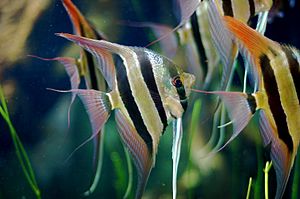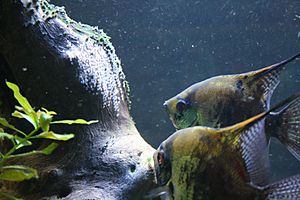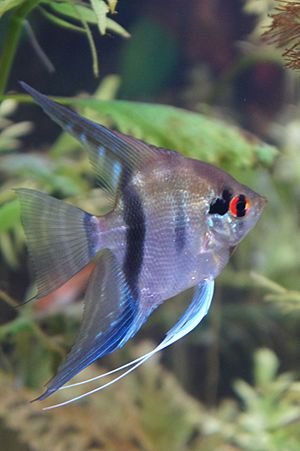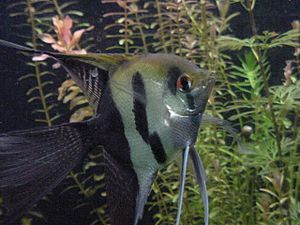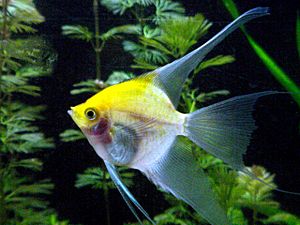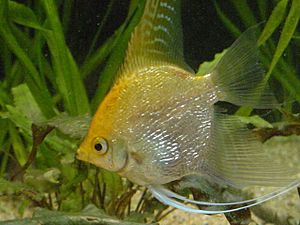Pterophyllum facts for kids
Quick facts for kids Freshwater angelfish |
|
|---|---|
 |
|
 |
|
| Scientific classification |
|
| Kingdom: | Animalia |
| Phylum: | Chordata |
| Class: | Actinopterygii |
| Order: | Perciformes |
| Family: | Cichlidae |
| Tribe: | Heroini |
| Genus: | Pterophyllum Heckel, 1840 |
| Type species | |
| Platax scalaris G. Cuvier, 1831
|
|
Angelfish are a type of freshwater fish from the family called Cichlidae. Most people know them simply as angelfish.
All angelfish species come from rivers in tropical South America. These include the Amazon Basin, Orinoco Basin, and other rivers in the Guiana Shield.
Angelfish have a unique, flat, round body with long, pointy fins. This shape helps them hide among plants and roots in the water. Wild angelfish often have stripes. These stripes help them blend in with their surroundings, like camouflage. Angelfish are predators that hunt small fish and insects.
Angelfish form pairs that stay together. They usually lay their eggs on a sunken log or a flat leaf. Like other cichlids, angelfish parents take good care of their young.
It's important not to confuse freshwater angelfish with marine angelfish. Marine angelfish live in shallow ocean reefs.
Contents
Types of Angelfish
There are three main types of angelfish in this group:
| Image | Scientific name | Where they live |
|---|---|---|
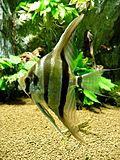 |
Pterophyllum altum Pellegrin, 1903 | Orinoco River Basin and Upper Rio Negro in Venezuela, Colombia, and Brazil. |
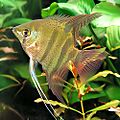 |
Pterophyllum leopoldi (J. P. Gosse, 1963) | Amazon River, Essequibo River, and Rupununi River. |
 |
Pterophyllum scalare (Schultze, 1823) (freshwater angelfish) | Amazon Basin in Peru, Colombia, and Brazil. |
Angelfish in Aquariums
Angelfish are very popular fish for home aquariums. They are loved for their special shape, colors, and how they behave. It wasn't until the late 1920s that angelfish were successfully bred in tanks in the United States.
Popular Species
The most common angelfish kept in aquariums is Pterophyllum scalare. Most of these fish are raised by breeders, not caught in the wild. Sometimes, you can find Pterophyllum altum that were also bred in tanks. Pterophyllum leopoldi is the hardest type to find in pet stores.
Caring for Angelfish
Angelfish need a warm aquarium, ideally around 80 °F (27 °C). Even though they are cichlids, they are usually peaceful. However, remember that "big fish eat little fish". This means angelfish might eat smaller tank mates. Good tank mates include Raphael Catfish, which have their own armor for protection.
Reproduction and Breeding
P. scalare are fairly easy to breed in an aquarium. However, after many generations of breeding, some angelfish have lost their natural parenting skills. This can cause them to eat their own young. It's also hard to tell if an angelfish is male or female until it's ready to breed.
Angelfish pairs form strong, lasting bonds. They protect each other from dangers and other fish. If one fish in a pair dies, the other might refuse to breed with any new partners.
P. scalare usually start breeding when they are 6 to 12 months old. If their eggs are removed after they lay them, the pair can lay new eggs every 7 to 10 days. After about three years, they will lay eggs less often and eventually stop.
When a pair is ready to breed, they pick a spot to lay eggs. They spend a day or two cleaning the surface. This spot could be a large plant leaf, a flat piece of slate, a pipe, or even the aquarium glass. The female lays a line of eggs, and then the male fertilizes them. This process repeats until they lay many eggs, from 100 to over 1,200.
Both parents take turns fanning the eggs with their fins. This helps water flow around the eggs. After a few days, the eggs hatch. The tiny fish, called fry, stay attached to the surface and eat their yolk sacs. After about a week, the fry start swimming freely. Successful parents watch over the eggs until then. Once the fry are free-swimming, they can be fed small live food.
P. altum are much harder to breed in an aquarium.
Living with Other Fish
In pet stores, freshwater angelfish are often called "semi-aggressive." Some types of tetras and barbs can live with angelfish. But if a fish is small enough to fit in an angelfish's mouth, it might be eaten. Make sure to feed your angelfish plenty of food so they don't get too hungry and bother their tank mates.
Aquarium Varieties
Most angelfish you see in pet stores today are the result of many years of selective breeding. This means people chose fish with certain traits to breed. The exact history of how different types of angelfish came to be is a bit unclear. This is because early breeders didn't always record which types of wild angelfish they crossed.
Today's domestic angelfish are likely a mix of genes from different wild species. They also have new traits from mutations that appeared over the last 60 years. This means domestic angelfish are true hybrids. They often look quite different from wild angelfish.
- Silver (+/+): These look most like wild angelfish, but they are bred in captivity. They have a silver body with red eyes and three black stripes. These stripes can get lighter or darker depending on the fish's mood.
- Gold (g/g): This type has a light golden body. Its head might be a darker yellow or orange. Gold angelfish do not have the black stripes or red eyes of wild angelfish.
- Zebra (Z/+ or Z/Z): Zebra angelfish have four to six vertical stripes. They look like silver angelfish in other ways.
- Black Lace (D/+) or Zebra Lace (D/+ - Z/+): These are silver or zebra angelfish with one "dark" gene. This gives their fins a beautiful lacy pattern.
- Smokey (Sm/+): This type has a dark brownish-grey back half. Its dorsal and anal fins are also dark.
- Chocolate (Sm/Sm): These are like smokey angelfish but with more dark patterns. Sometimes, only their head is silver.
- Halfblack (h/h): These angelfish are silver with a black back half. This pattern might not show up if the fish are stressed.
- Sunset Blushing (g/g S/S): This type has two gold genes and two "stripeless" genes. The best ones have an orange color on their upper half. Their body is mostly white, and their fins are clear. The amount of orange can vary. Young ones have clear gill plates, making their pink gills visible, which is where the "blushing" name comes from.
- Koi (Gm/Gm S/S) or (Gm/g S/S): Koi angelfish have one or two gold marble genes and two stripeless genes. Their orange color changes with stress. They have black marbling that covers 5% to 40% of their body.
- Leopard (Sm/Sm Z/Z) or (Sm/Sm Z/+): Leopard angelfish are popular when they are young because they have spots all over. As they grow, the spots get closer together, making them look like chocolate angelfish with dots.
- Blue Blushing (S/S): This wild-type angelfish has two stripeless genes. Its body is grey with a blue tint under the right light. As they get older, they develop a shiny, iridescent color, usually blue.
- Silver Gold Marble (Gm/+): This is a silver angelfish with one gold marble gene.
- Ghost (S/+): These are mostly silver fish with just a stripe through the eye and tail. Sometimes, parts of their body stripes might show.
- Gold Marble (Gm/g or Gm/Gm): The amount of marbling (black patterns) on these fish ranges from 5% to 40%, depending on their genes.
- Marble (M/+ or M/M or M/g or M/Gm): Marble angelfish have much more black pattern than gold marble types. Their marbling covers 50% to 95% of their body.
- Black Hybrid (D/g or D/Gm): This is a cross between a black and a gold angelfish. The result is a very strong black fish that might look shiny when young. This type does not breed true (meaning their offspring won't always look the same).
- Pearlscale (p/p): Pearlscale is a change in the scales. It's also called "diamond" angelfish because its scales sparkle like gems. The scales look wavy and reflect light. This trait develops slowly, starting around 9 weeks old. Stress can stop it from developing. Both parents must have this gene for it to show up.
- Black Ghost (D/+ - S/+): These are similar to ghost angelfish but look darker because of the "dark" gene. They are also very similar to black lace angelfish without full stripes. Ghosts usually have more shine than normal angelfish.
- Albino (a/a): Albino removes dark colors from most types of angelfish. Some, like albino marble, might still have a little black. Their eye pupils are pink, like all albino animals. The colored part of their eye can be red or yellow.
Images for kids
See also
 In Spanish: Pterophyllum para niños
In Spanish: Pterophyllum para niños


